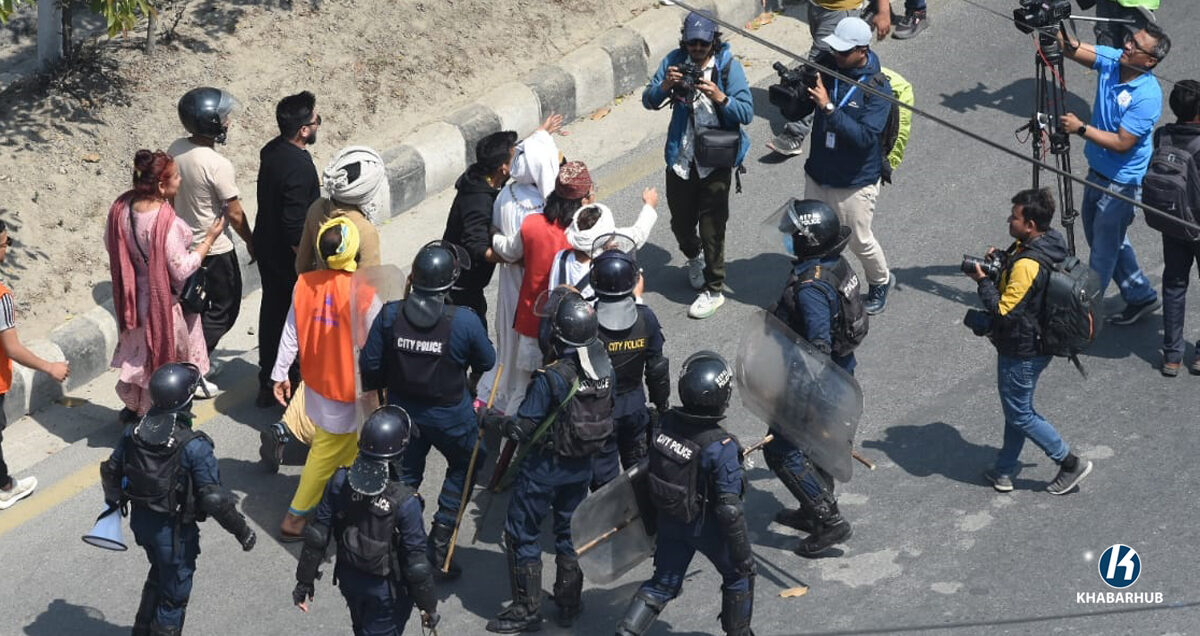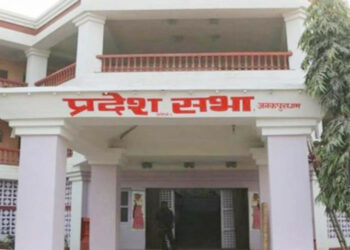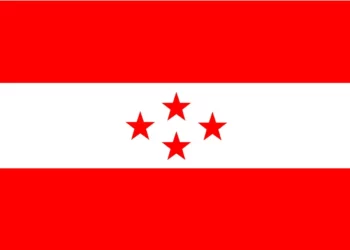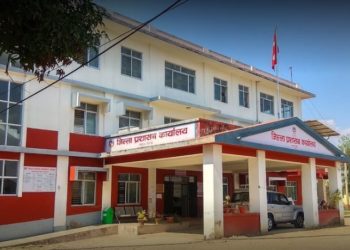KATHMANDU: The pro-monarchy rally, led by Nawaraj Subedi, medical entrepreneur Durga Prasai, and controversial religious leader Acharya Niwas, took a violent turn on Friday.
A private house in Tinkune, Kathmandu, was damaged by stone-pelting and later set on fire. Protesters also attacked the offices of Annapurna Post and Kantipur Television.
In Parisdanda, a government vehicle was set ablaze, while reports of vandalism and looting emerged from the Bhatbhateni Superstore in Koteshwor and the office of the Unified Socialist Party in Aloknagar. Protesters reportedly looted expensive liquor from Bhatbhateni Superstore.
The most tragic aspect of the unrest was the loss of two lives during the clashes. A total of 22 security personnel and protesters were injured. Additionally, a journalist was reportedly killed in a fire. Personal property and vehicles were also torched.
Mobs tried to attack the residence of Madhav Nepal, while a taxi was burned near the CPN-UML office. An arson attack near the Civil Aviation Authority office disrupted flights.
Successful movements require leadership characterized by patience, discipline, and a credible commitment to non-violence. However, figures like Durga Prasai, Nawaraj Subedi, and Rabindra Mishra have not demonstrated such maturity or restraint.
Vehicles were set on fire in Lokanthali and Balkumari. In a particularly alarming incident, Rastriya Swatantra Party (RSP) leader Santosh Pariyar was forcibly removed from his vehicle, which was then set ablaze. Further details on the extent of the damage are yet to be released.
A serious question has arisen: Should the organizers of this movement take responsibility for the violence, arson, and destruction of private and public property in the name of restoring the monarchy?
The protest, reportedly held under the patronage of former King Gyanendra Shah, has raised concerns about whether it was truly peaceful or veered into planned violence.
The organizers cannot simply evade responsibility by blaming police intervention.
Observing the events, it is clear that the protesters initially exercised restraint, but the leadership failed to maintain control over the situation.
Instead of addressing their supporters and ensuring discipline, the leaders of the movement seemed to disappear when tensions escalated.
Protesters claim that police fired tear gas at the stage in Tinkune. However, in response, the movement’s key figures—Durga Prasai, Rabindra Mishra, Acharya Niwas, Nawaraj Subedi, and Dhawal Shumsher Rana—were notably absent from the scene.
Reports suggest that they stayed at home or went into hiding. What kind of leadership flees the field in the face of confrontation? Can a movement sustain itself without its commanders?
If these leaders were truly committed to their cause, they should have remained at the frontline, addressing their supporters, appealing for non-violence, and peacefully confronting police intervention.
Instead, their absence left a chaotic crowd to act on its own, resulting in violent attacks on media houses, political offices, and individuals’ homes. This raises questions about whether the violence was spontaneous or premeditated.
Durga Prasai had repeatedly declared his intention to “enter the houses of leaders and attack them.” His inflammatory rhetoric, widely circulated on social media, seems to have translated into action.
The attack on the office of the relatively weak Unified Socialist Party appears to align with Prasai’s calls for aggression. Furthermore, scenes of protesters looting liquor stores have tainted the legitimacy of the royalist movement.
Given that Hinduism considers alcohol impure, under whose command did these supposed defenders of a Hindu state engage in such looting? This warrants serious investigation.
Those who claim ownership of Friday’s protests must now demonstrate the moral courage to take responsibility for the violent incidents that transpired.
It should be noted that a genuine people’s movement follows principles, discipline, and a clear ideological foundation. It does not materialize simply because a few individuals demand it.
For a movement to be successful, both objective and subjective conditions must be ripe. A monarchy cannot be restored simply through sporadic protests or short-lived demonstrations.
Unrest and anarchy, as seen in Iraq following the murder of Nepali workers in 2004, cannot bring about meaningful change.
Has the former king lost faith in the promising leaders of the RPP and instead placed his trust in Durga Prasai’s aggressive, apolitical, and inflammatory rhetoric?
Successful movements require leadership characterized by patience, discipline, and a credible commitment to non-violence. However, figures like Durga Prasai, Nawaraj Subedi, and Rabindra Mishra have not demonstrated such maturity or restraint.
Nepal’s democratic transformation was not achieved overnight through terror or violence. Historical movements evolved over decades: Mahendra staged a coup in 1960, a referendum was held in 1980, multi-party democracy was reinstated in 1990, and the long journey toward constitutional transformation culminated in 2015. Change is a process, not an event.
It is unlikely that the monarchy will return in the lifetime of Gyanendra Shah or Durga Prasai. Figures like Kamal Thapa and Rajendra Lingden may have to fight for their beliefs for decades. A true people’s movement cannot be built on rash declarations to reinstate the king before 2028.
What has to be noted is that there is a legitimate pathway for monarchists to regain the people’s trust, influence public opinion, and amend the constitution through a two-thirds majority.
However, this requires unity and the establishment of a strong political party. Simply making speeches on YouTube or TikTok, or undermining established leaders like Kamal Thapa and Rajendra Lingden, will not achieve this goal.
The failure of disorganized leadership—exemplified by the reckless command of ‘Janakmandar’ on Friday—has already proven this point.
While Kamal Thapa and Rajendra Lingden have been steadily working towards forming a credible monarchist party, what was Durga Prasai, who frequently accuses them, doing until recently? What was he saying?
While Prasai was dining with KP Sharma Oli and Prachanda, singing praises of the republic, Kamal Thapa and Rajendra Lingden were advocating for the restoration of the monarchy.
Today, those very leaders are being vilified, while figures who once supported the republic are now leading a violent movement in the name of the king. History, it seems, has its ironies.
A significant moment in the discourse on monarchy came when RPP leader Kamal Thapa delivered a memorable speech in Itahari. Responding to critics demanding an immediate return of the Hindu nation and monarchy, he provided a rational argument to those in haste.
Reviewing the chain of events, it is evident that the former king’s call, his implicit encouragement, and the strategic maneuvering behind the scenes played a role in what unfolded.
“If you want a Hindu nation, should you vote for Nepali Congress, UML, and the Maoists? If the majority of Hindus had voted for RPP, wouldn’t the monarchist movement have gained more strength? And is it just that we want a king immediately, or do we seek a lasting monarchy? We may have to wait. The monarchy can only return by winning the trust of the people. It cannot return through rebellion, and even if it does, such a monarchy would not endure.”
This raises a crucial question: Did Durga Prasai seek to restore the monarchy through rebellion? Has Gyanendra Shah deviated from the strategic approach taken by Rajendra Lingden and Kamal Thapa—one that seeks to reintroduce monarchy through democratic means and public support?
There is an old saying: “It is not achieved through a mother’s milk but by the father’s struggle.”
Has the former king lost faith in the promising leaders of the RPP and instead placed his trust in Durga Prasai’s aggressive, apolitical, and inflammatory rhetoric?
If so, it is not a path to resurgence but to downfall. Nirmal Niwas must have glimpsed the depth of this misstep on Friday.
The monarchy will not return by looting beer or alcohol. The Hindu nation will not be re-established by burning people’s houses. A civilized society cannot be built by attacking the media.
To understand the recent violent protests led by monarchists, we must revisit the evening of Falgun 6.
On that day, former King Gyanendra Shah released a video message, declaring:
“Now the time has come. If we want to save the nation and preserve national unity, we call upon all countrymen to support us for the prosperity and progress of the country.”
At the time, the former king had been staying in Pokhara for a month. He issued this statement from there. When he returned to Kathmandu, royalists welcomed him at the airport and escorted him to Nirmal Niwas in a grand procession.
Among those actively participating were Durga Prasai, Kamal Thapa, and Rajendra Lingden. However, Prasai, rather than acknowledging the role of the RPP, sought to claim the moment for himself.
Following Gyanendra Shah’s message, RPP central member Nawaraj Subedi informed a party meeting that he had received a directive from the former king to lead the movement.
How can anyone be expected to support such a movement after witnessing the looting of liquor, refrigerators, fruits, vegetables, and other goods from Bhatbhateni Superstore?
The next day Subedi resigned from the RPP in a program held at a Dillibazaar restaurant and declared himself the coordinator of the Joint People’s Movement Coordination Committee for the Restoration of the Monarchy.
Despite including Rajendra Lingden and Kamal Thapa in his proposed committee, neither leader agreed to participate. However, Durga Prasai aligned himself with Subedi.
Last Thursday, Subedi and Prasai visited Nirmal Niwas, seeking the former king’s blessing for the movement. After leaving the palace with his advice, Prasai was informally declared the ‘peoples’ commander’ of the movement.
The very next day, on March 28, when this so-called ‘commander’ arrived in Tinkune, violence erupted—homes were set on fire, property was vandalized, and even weapons were seized from the police.
Reviewing the chain of events, it is evident that the former king’s call, his implicit encouragement, and the strategic maneuvering behind the scenes played a role in what unfolded.
From Nawaraj Subedi’s resignation from the RPP to the formation of a new front with Durga Prasai—sidestepping Kamal Thapa and Rajendra Lingden but including Dhawal Shumsher Rana—the sequence of actions aligns with Gyanendra’s words from Falgun 6: “Now the time has come. If we want to save the nation and maintain national unity, we call upon all countrymen to support us for the prosperity and progress of the country.”
This movement was not spontaneous; it was engineered. However, the question remains—was it strategically sound, or has it only deepened the monarchy’s distance from the people?
Now, will the government now arrest, interrogate, or take legal action against the alleged coordinator, patron, and leader of this violent incident? That remains to be seen. The government’s response will determine how seriously it takes this matter.
Durga Prasai was the commander of Friday’s movement, while Nawaraj Subedi acted as its coordinator. RPP Chairman Rajendra Lingden has already clarified that the RPP was not behind this event.
However, the presence of RPP leader Rabindra Mishra at the protest has raised suspicions about the party’s internal divisions. The RPP is visibly split into two factions—one liberal, the other extremist.
Durga Prasai had been openly advocating for violent actions, urging his supporters to attack the homes of political leaders. These statements are widely documented on social media. However, after Friday’s chaos, he suddenly changed his stance, saying, “I sincerely appeal to everyone not to attack private property.”
Meanwhile, pro-monarchy leader Kamal Thapa has rightly said: “We do not support restoring the monarchy through rebellion. Such a return would not be sustainable.”
How can anyone be expected to support such a movement after witnessing the looting of liquor, refrigerators, fruits, vegetables, and other goods from Bhatbhateni Superstore?
Can the horrific sight of homes being set on fire and people being burned alive encourage more citizens to join Durga Prasai’s so-called movement? Will anyone stand behind a leader whose movement turns cities into battlegrounds, setting fire to houses and cars?
The terror unleashed on Friday under Prasai’s command has likely set the royalist movement back by decades. Instead of strengthening the cause, it has delivered a severe blow to it.
Prasai, who previously incited people to attack leaders’ homes, is now backtracking in frustration, pleading for peace.
It may be noted that several incidents confirm that former King Gyanendra Shah has repeatedly made short-sighted political decisions.
The violent nature of Friday’s royalist protests raises a critical question: Does the former king seek a peaceful return to the throne, or does he believe power can be reclaimed through riots and destruction?
This leads to another crucial dilemma for Gyanendra—can he genuinely expect to become a constitutional king through violent tactics like those seen on Friday? Or will this attempt end up as another historical blunder?
One thing is certain—no monarchy restored through bloodshed and chaos can sustain itself.
Meanwhile, pro-monarchy leader Kamal Thapa has rightly said: “We do not support restoring the monarchy through rebellion. Such a return would not be sustainable.”
This statement serves as a stark warning. If the royalist movement continues on its current path of violence and division, it will only push monarchy further away from the people—perhaps permanently.









Comment